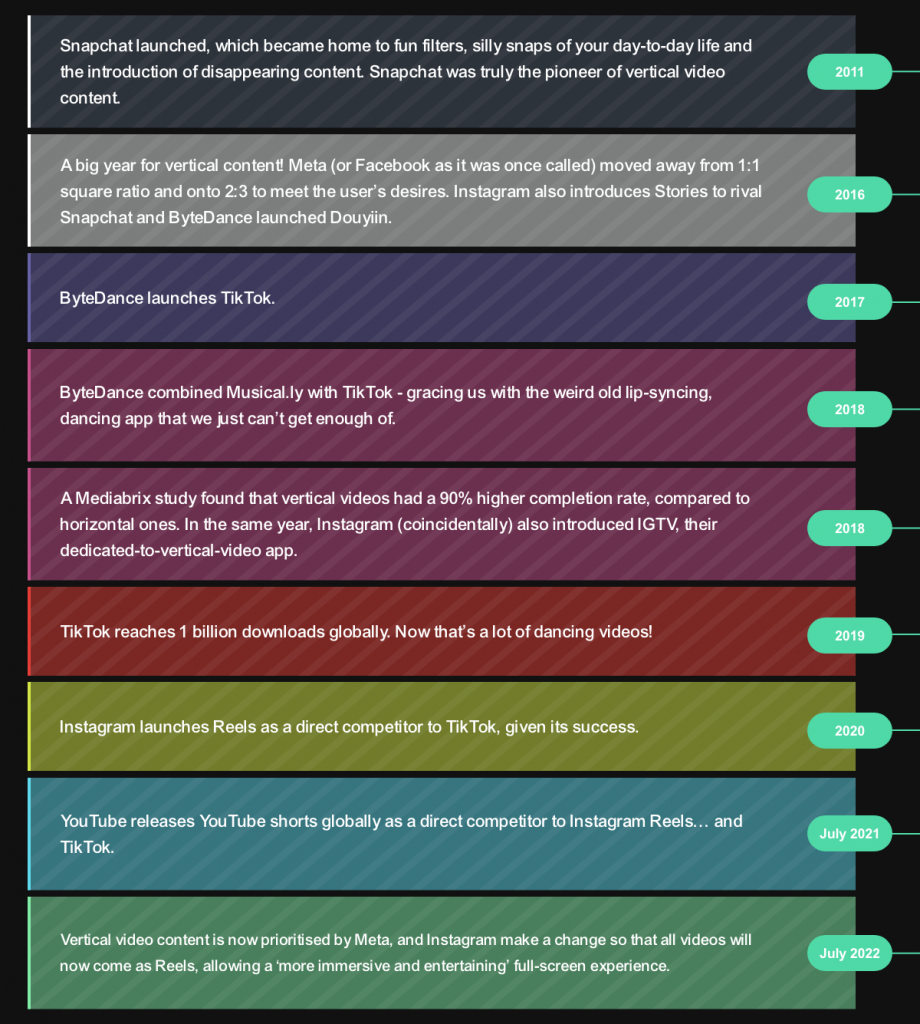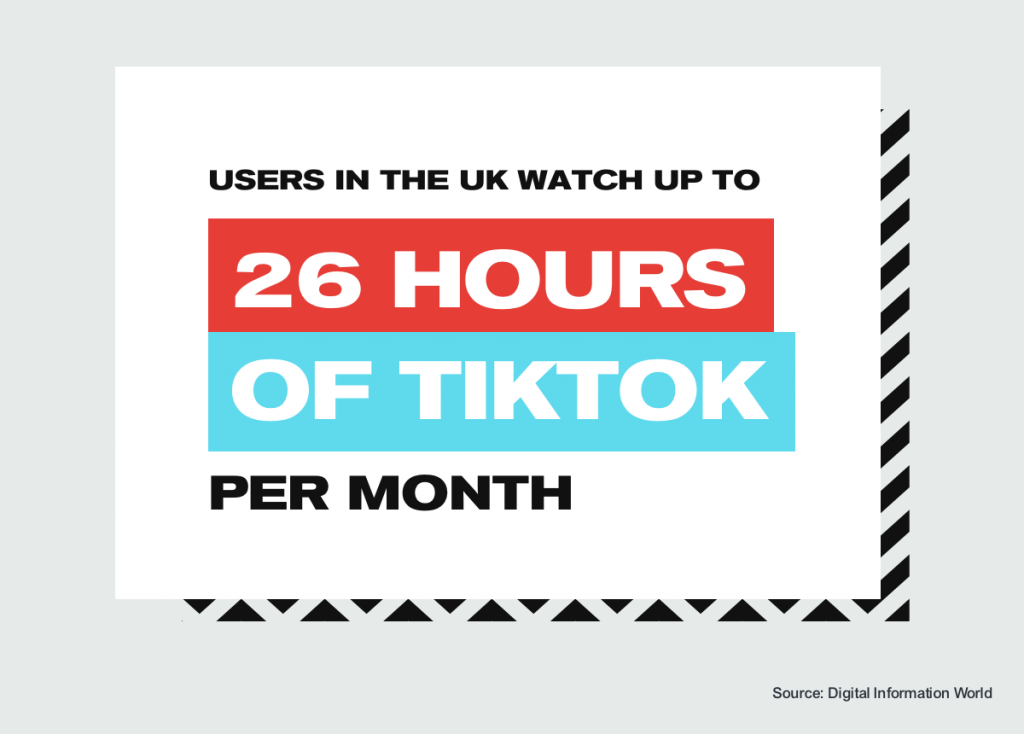24 August 2022
How do I set up a Google Analytics 4 property?
Read More

Vertical video content has taken over our social media feeds, and all for a good reason! (We’re looking at you, TikTok…)
Maybe you were once ridiculed for sending your friends, family or colleagues a video in vertical format with those large gaping black spaces at either side. After all, everyone in the marketing industry should know that videos NEED to be filmed horizontally, right? Wrong!
Times are changing, with Instagram recently announcing their switch to full-screen viewing, alongside giving Reels their time to shine in the spotlight.
So, it looks like just about everyone’s jumping aboard the vertical video bandwagon, and you might have to too.
Vertical video is exactly what it says on the tin: video content, but make it vertical.
With over 75% of videos consumed on mobile, vertical videos are a great way to consume content, as the aspect ratio is tailored to the size of the modern mobile phone. At an aspect ratio of 9:16, the exact opposite of traditional horizontal video at 16:9, vertical video is designed to fill the entirety of your screen.
All sounds simple, right? We thought so too, but it seems to be causing quite a stir. But we’ll get to that later.
For now, let’s take a journey down memory lane…
Way back when, the vertical video was seen as the laughing stock of social media uploads when horizontal video was on top. You’d see a narrow vertical video with a vast black space on either side, instantly turning viewers away. Our world was once solely horizontal, with computer screens, TV screens and the cinema all made for landscape viewing, but not anymore.
So, let’s go right back to the beginning of the vertical video trend, starting all the way back in 1932…
1932: The Academy ratio of 1:37:1 was standardised by the Academy of Motion Picture Arts and Sciences as the standard film aspect ratio…
Just kidding, let’s fast-forward straight to 2011:

A brief history of vertical video:
And phew! You’re all caught up in the wonderful world of vertical video.
You’re likely reading this on your phone, and if you’re reading this on your phone, it’s likely you’re holding it vertically…
That’s right – smartphone users hold their phones vertically 94% of the time, so when making content, you should cater to the majority. Over 70% of millennial and Gen Z users say vertical video makes the whole experience feel a lot more personal and immersive, and studies even show that most millennials refuse to flip their phone to watch a video horizontally, because at the end of the day, we’re all lazy.
The likes of TikTok now dominate our screens, with people spending approximately 26(!) hours a month on the dancing app, so it seems that flipping your phone around has become a thing of the past. Whether it be an advert, a DIY tutorial or a cute video of your dog, people want to consume content quickly and easily.

So, if you aren’t catering to the lazy needs of your customers, you’re not allowing them to see the full extent of your content, and thereby they may scroll past or miss an important aspect of your ad. By catering to the rise of vertical video, you’re helping your brand stay relevant, accessible and engaging.
Vertical video is causing quite the uproar with some, as yes, it does have its limitations, such as:
All that being said, it still triumphs in the modern world of smartphones.
Even the likes of YouTube, the top dog in landscape video, are beginning to embrace vertical viewing. As after all, there’s no point in battling against your customers’ wants and needs; you need to work with them!
Capturing video footage on your phone will never be as high-quality and polished as it would be from a video camera, and it may feel like your videos always look a bit, well, naff.
But that might just be because you haven’t got the right tools to bring out the best of your video content. So, let’s take a look at a few pieces of software you may want to consider.
When it comes to editing, your mind probably goes to Adobe. Perfect for desktop or mobile, at home or on the go, Rush is made to help you go from capturing to editing to posting, pronto. Championed for its flexibility and ease of use, Adobe Rush allows you to get creative with graphics and audio and export to any social media platform in various aspect ratios at the click of a button.
Whether you’re a professional, a video enthusiast or just starting out, Viva Cut is loved by many. Also allowing you to export in different aspect ratios, Viva Cut opens up a world of possibilities for video editing. With tools for VFX, transitions, blending and more, and special effects plugins, Viva Cut is there to help you make your vertical videos look fantastic.
With vertical video content ever on the rise, more and more editing software are popping up left right and centre. So, take your time researching what is right for you, and get ready to get creative!
So, you know that vertical video is absolutely essential for building great content, but the main question now is, where do you start?
Don’t worry, we’ve collected a few top tips to get you well on your way to creating superb content for vertical viewing.
After a lot of time spent scrolling, you’ve probably seen millions of fun videos to take inspiration from. However, remember not to just take that format and copy it into your own branding, as tempting as that may be. With creative shots and good editing software, you can start experimenting to create something fun and cutting edge, something that’ll make others think, “Wow, I wish we had that idea first!”.
Surprisingly, 85% of people on Facebook scroll and watch videos without sound, only turning up the volume when it really sparks their interest. As such, you must make your videos engaging enough to make people want to hear the sound.
Use innovative video shots and fun graphics, alongside captions to make it an all-around more accessible experience. Also, watch your videos back without the sound so they make sense with or without.
Remember, although a video editing tool will benefit your content, don’t go too crazy on production quality. One of the joys of platforms like TikTok is the authenticity, the ability to capture things in the moment rather than spending a lifetime on a high-end, shiny advert. People love it when things look natural, so keep things simple, but effective.
A few more top tips:
It doesn’t look like vertical video will be leaving us anytime soon, so it’s time to embrace the thing we once mocked.
But don’t worry, your TV and cinema screens won’t be playing vertically, but then again, who knows…
Why not email hello@little.agency or call 0113 828 0000 to find out how we can help you to transform your content marketing.


Still the same great data driven services, but now with a different name